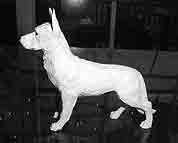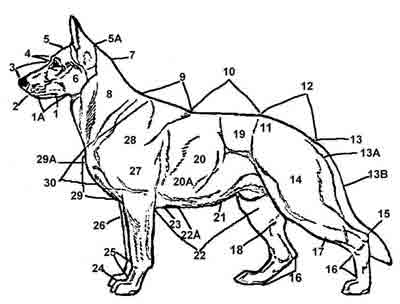Derived from the old breeds of herding and farm dogs and associated for centuries with man as servant and companion, the German Shepherd Dog has been subject to intensive development. Sponsored by the "Verein fur Deutsche Schaferhunde," the parent club of the breed founded in 1899 in Germany, the cult of the Shepherd spread rapidly from about 1914 onward in many parts of the world. Specialty clubs in many lands have fostered interest in the breed, as it has been in the United States by the German Shepherd Dog Club of America.
First, last and all time a working dog, the German Shepherd has been developed both temperamentally and structurally through selective breeding, through judging which, on the whole, has been of a constructive character, and through specialized training.
Considering first the more important side of the dog--its character--the Shepherd is distinguished for loyalty, courage, and the ability to assimilate and retain training for a number of special services. He should be of equable disposition, poised, unexcitable, and with well-controlled nerves. For his typical work as a herding sheep dog, he must not be gun-shy and must have courage to protect his flock from attacks, either animal or human. For his work as a police dog, a development that followed upon a natural aptitude for training, he must have this courage also, but in addition, must be able to make use of the excellent nose, which he usually possesses. In his work as a leader of the blind, the Shepherd must and does exhibit a high order of intelligence and discrimination involving the qualities of observation, patience, faithful watchfulness, and even, to a certain degree, the exercise of judgment.
These qualities, which have endeared the German Shepherd Dog to a wide public in practically every country of the globe, are those of the companion, protector, and friend. The German Shepherd is not a pugnacious brawler, but a bold and punishing fighter if need be. In his relation to man he does not give affection lightly; he has plenty of dignity and some suspicion of strangers, but his friendship, once given, is given for life.
On the physical side, the German Shepherd has been developed to a point of almost ideal fitness for the work he is called upon to do. He is a dog of middle size with enough weight to be effective as herder or patrolman, but not enough to be cumbersome or unwieldy.
By careful selective breeding, the naturally easy trot of the German Shepherd Dog has been brought to a high pitch of nearly effortless motion. Essentially a trotting animal, his structure has been modified so as to increase the power, elasticity and length of his gait. Other things being equal, the best moving Shepherd is the one, which covers the maximum amount of ground with the minimum expenditure of energy. So well coordinated and harmonious is this gait when properly exemplified that the dog seems to glide forward without visible effort, suspended, one might think, from the firm beam of his back.
The impression of the dog as a whole is one of ruggedness combined with nobility, of power combined with agility. There should be a sense of balance, forequarter and hindquarter compensating each other in their development. The outline should be smooth and flowing, and the top line of the dog, from ear to the tip of the full tail, a single sweeping succession of unbroken curves. The German Shepherd is a natural dog, unchanged for any whim of the show ring.

The color "white" can be traced back to the roots of the German Shepherd Dog. Information provided in early books on the German Shepherd Dog, such as "The Alsatian WoIf Dog" written by George
Horowitz in 1923, as well as "The German Shepherd, Its History, Development and Genetics" written by M. B. Willis in 1977, make mention of white German Shepherd shown in Europe as early as 1882.
"Der Deutsche Schaferhund In Wart Und Bild" written by Rittmeister Max von Stephanitz, the architect of the German Shepherd breed, in 1921 included a photo of a white German Shepherd directly descended from Horand (mentioned later herein), and "The Complete German Shepherd" published by Milo Denlinger in 1947, included an illustration of a white German Shepherd from Northern Germany.
It is a historical fact that a white dog was the grandsire of Horand von Grafrath born in 1895, the dog who was acknowledged as the foundation dog of contemporary German Shepherd Dog bloodlines. From that time forward, the color white was part of the genetic pool within the color variations of the German Shepherd Dog.
In the United States, the white German Shepherd appears throughout the history of the breed. In the early 1920's Ann Tracy (who owned one of the first two German Shepherd champions on record in America). Imported some of the finest German show stock to this country and white puppies showed up immediately in her litters. In 1917, the first white German Shepherds were registered with the American Kennel Club from Ann Tracy's kennels. In the 1920's, H. N. Hanchett of Minnesota imported German-bred white German Shepherds to the United States. Early top German lines, such as V. Oeringen were recognized as an excellent source for white German Shepherds. The Strongheart, Rin-Tin-Tin and Longworth bloodlines frequently produced white dogs.
THE CONTROVERSY
It was not until the 1930's. after the death of Max von Stephanitz, that white dogs were discriminated against. The discrimination increased with the rise of Hitler. During the 1960's, with the white German Shepherd becoming ever more popular, friction developed between breeders of the white German Shepherd and the standard colored German Shepherd. Genetic problems appearing in the German Shepherd Dog were increasingly blamed on the white German Shepherd, and Germany began a campaign to outlaw the white color. One charge against the white German Shepherd was that the color white was responsible for "fading color" or "washing out" of the darker dog's color. This point has been refuted innumerable times by leading breeders and geneticists. However, in 1968, following Germany's lead, the white German Shepherd was disqualified from the conformation show ring in America when AKC accepted the change in the breed standard from the German Shepherd Dog Club of America listing white as a disqualifying fault. To its credit, the AKC has not bowed to demands that it cease registering the white dog.


